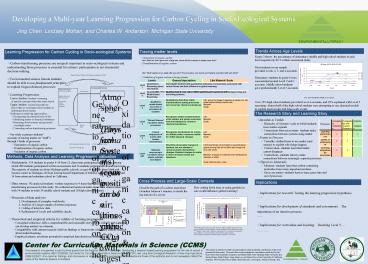Developing a Multiyear Learning Progression for Carbon Cycling in SocioEcological Systems - PowerPoint PPT Presentation
1 / 1
Title:
Developing a Multiyear Learning Progression for Carbon Cycling in SocioEcological Systems
Description:
Figure 2 shows the percentages of elementary, middle and high school students at ... How cutting down trees or using gasoline in cars would influence global warming? ... – PowerPoint PPT presentation
Number of Views:32
Avg rating:3.0/5.0
Title: Developing a Multiyear Learning Progression for Carbon Cycling in SocioEcological Systems
1
Developing a Multi-year Learning Progression for
Carbon Cycling in Socio-Ecological Systems
Jing Chen, Lindsey Mohan, and Charles W.
Anderson, Michigan State University
Trends Across Age Levels
Tracing matter levels
Learning Progression for Carbon Cycling in
Socio-ecological Systems
Figure 2 shows the percentages of elementary,
middle and high school students at each level
respectively for 9 written assessment items.
Most students in our sample provided Levels 2,
3, and 4 accounts. Elementary students in
grade-4 were concentrated around Level 2 and 3
accounts. Middle school students gave
predominantly Level 3 accounts.
note Level 0 indicates a blank or no response
Over 35 high school students provided Level 4
accounts, and 10 explained with Level 5
reasoning. Almost half of the high school
students were attempting to use chemical models
to explain macroscopic and large-scale events.
- Generation of organic carbon
- Item When an acorn grows into a large tree,
where did the increases in weight come from? - Transformation of organic carbon
- Item What happens to an apple after you eat
it? How are grass, cow, human and bacteria
connected with each other? - Oxidation of organic carbon in living systems
- Item What happens to an apple/a dead tree
when it rots? When Jared lost weight, where did
the mass of his fat go? - Oxidation of organic carbon in human systems
- Item What happens to a match when it
burns? What happens to gasoline when it burns?
- Carbon-transforming processes are uniquely
important in socio-ecological systems and
understanding those processes is essential for
citizens participation in environmental
decision-making. - Environmental science literate students
- should be able to use fundamental principles
- to explain biogeochemical processes.
- Learning Progression
- Lower Anchor students reasoning
- of specific concepts when they enter school.
- Upper Anchor societal expectations
- about what we want high school students to
- understand about science.
- Challenges in achieving upper anchor
- Recognizing the chemical basis of life
- Identifying matter or chemical substances
- Reasoning about systems and processes
- at multiple scales
- Connecting carbon-transforming processes
The Research Story and Learning Story
- Invisible to Visible
- Hierarchy of Systems- scale at which students
- trace matter expands
- Connections between systems- students make
connections between systems using matter - Events to Process
- Causality- student learn to use matter (and
- energy) to explain why things happen
- Conservation- students learn that matter
- cannot disappear
- Connections- students learn to make
- connections between seemingly separate
processes - Objects to Materials
- Mixtures- students learn that carbon-containing
molecules form many important mixtures - Gases are matter- students learn to trace gases
into and out of processes
Methods, Data Analysis and Learning Progression
Validation
- Participants 314 students in grades 4-10 from 12
classrooms participated in this study, among
which 280 students participated written
assessments and 34 students participated clinical
interviews. The majority of students are from
Michigan public schools, except 40 students from
Math and Science center in Michigan, 20 from
Korean-based Department of Defense school in
Michigan and 14 from urban and suburban school in
California. - Data source We analyzed students written
responses to 9 items that focusing on
carbon-transforming processes for this study. We
collected and analyzed audio tapes from clinical
interviews with 34 students in total (14 middle
school students and 20 high school students). - Processes of data analysis
- 1. Development of exemplar workbooks.
- 2. Analysis of a larger sample of written
responses. - 3. Coding of interview data.
- 4. Refinement of Levels and reliability
checks. - Theoretical and empirical criteria for validity
of learning progressions - Conceptual coherence tells a comprehensible and
reasonable story of how initially naïve students
can develop mastery in a domain. - Compatibility with current research build on
findings or frameworks of the best current
research about student learning. - Empirical criteria assertions grounded in
empirical data about real students
Cross Process and Large-Scale Contexts
Implications
How cutting down trees or using gasoline in cars
would influence global warming?
students gave Level 3 accounts, and were unable
to identify atomic-molecular processes related to
global warming, or chemical identities of key
materials involved. identify or name carbon
dioxide as a key product of combustion and
reactant in photosynthesis, or as a key substance
responsible for global warming. students
connected photosynthesis and combustion to CO2
levels
Describe the path of a carbon atom from Grandma
Johnsons remains, to inside the leg muscle of a
coyote.
- Implications for research Testing the learning
progression hypothesis. - Implications for development of standards and
assessments The importance of an iterative
process. - Implications for curriculum and teaching
Reaching Level 5. - ..
The authors would like to thank several people
for their invaluable contributions to the work
presented in this poster. We would like to
acknowledge the contributions made by Hui Jin,
Hsin-Yuan Chen, Kennedy Onyancha, and Hamin Baek,
from Michigan State University and Karen Draney,
Mark Wilson, Yong-Sang Lee, and Jinnie Choi, at
the University of California, Berkeley. We would
also like to thank Alan Berkowitz, Joe Krajcik,
JoEllen Roseman, and Carol Smith for giving us
suggestions.

